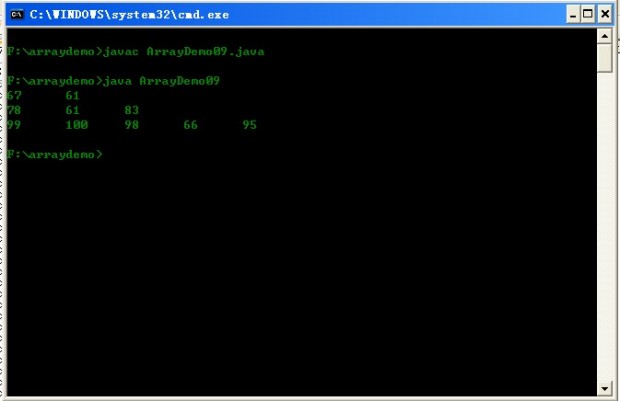java数组定义及使用
3.1数组
数组是一组相关数据的集合,数组按照使用可以分为一维数组、二维数组、多维数组
有点: 不使用数组定义100个整形变量:int1,int2,int3;;;;;; 使用数组定义 int i[100] 数组定义:int i[100],只是一个伪代码,只能表示含义的。3.2一维数组
可以存放上千万个数据,并且这些数据的类型是完全是相同的。
要使用java的数组,必须经过两个步骤:(1)声明数组,(2)分配内容给该数组,这两个步骤的语法如下: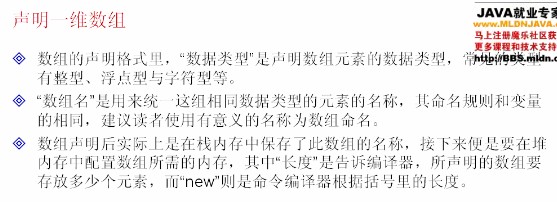
声明形式一:
◇声明一维数组: 数据类型 数组名[] = null; ◇分配内存给数组:数组名 = 买受人数据类型[长度] 声明形式二: ◇声明一维数组: 数据类型[] 数组名 = null;public class ArrayDemo01{public static void main(String args[]){int score[] = null; //声明数组score = new int[3]; //为数组开辟空间}}
public class ArrayDemo01{public static void main(String args[]){int score[] = null; //声明数组score = new int[3]; //为数组开辟空间System.out.println("score[0] = " + score[0]);System.out.println("score[1] = " + score[1]);System.out.println("score[2] = " + score[2]);}}
public class ArrayDemo01{public static void main(String args[]){int score[] = null; //声明数组System.out.println("score[0] = " + score[0]);System.out.println("score[1] = " + score[1]);System.out.println("score[2] = " + score[2]);}}
public class ArrayDemo01{public static void main(String args[]){int score[] = null; //声明数组score = new int[3]; //为数组开辟空间System.out.println("score[0] = " + score[0]);System.out.println("score[1] = " + score[1]);System.out.println("score[2] = " + score[2]);for(int x=0;x<3;x++){System.out.println("score["+x+"] = " + score[x]);}}}
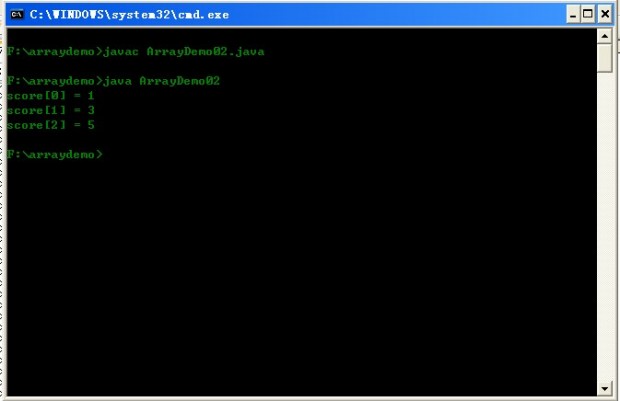 访问注意:
假设程序中取出的内容超过了这个下标,如"score[3]",则的程序运行的时候会出现以下的错误提示:
java.lang.ArrayIndexOutOfBoundsException:3
访问注意:
假设程序中取出的内容超过了这个下标,如"score[3]",则的程序运行的时候会出现以下的错误提示:
java.lang.ArrayIndexOutOfBoundsException:3
public class ArrayDemo01{public static void main(String args[]){int score[] = null; //声明数组score = new int[3]; //为数组开辟空间System.out.println("score[0] = " + score[0]);System.out.println("score[1] = " + score[1]);System.out.println("score[2] = " + score[2]);for(int x=0;x<3;x++){System.out.println("score["+x+"] = " + score[x]);}System.out.println("score[3] = " + score[3]);}}
public class ArrayDemo02{public static void main(String args[]){int score[] = null; //声明数组score = new int[3]; //为数组开辟空间for(int x=0;x<3;x++){ //为每个元素赋值score[x] = x*2+1; //每一个值都是奇数}for(int x=0;x<3;x++){System.out.println("score["+x+"] = " + score[x]);}}}
public class ArrayDemo03{public static void main(String args[]){int score[] = null;score = new int[3];System.out.println("数组长度为:" + score.length);}}
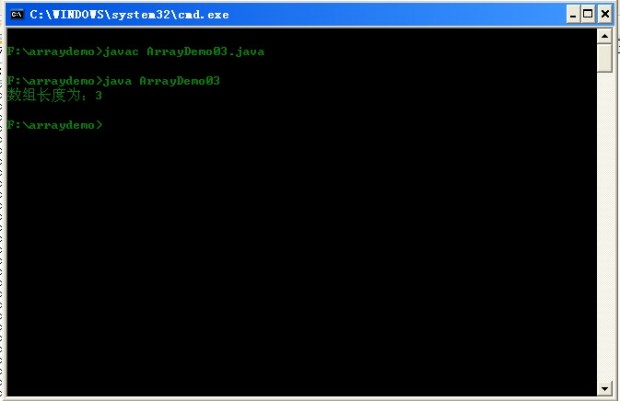
3.3数组的静态初始化
之前所看到的数组,所采用的方式都是动态初始化,即:所有的内容在数组声明的时候并不具体的制定,而都是以默认值的形式以出现。 静态初始化就是指在数组定义之后,直接制定好期内容。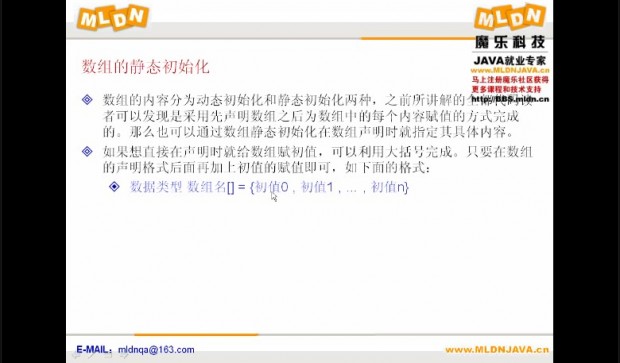 操作格式:
数据类型 数组名[] = {初值0,初值1,....,初值n}
操作格式:
数据类型 数组名[] = {初值0,初值1,....,初值n}
public class ArrayDemo04{public static void main(String args[]){int score[] = {91,92,93,94,95,96}; //使用静态初始化的方式初始数组。for(int x=0;x<score.length;x++){ //循环输出System.out.println("score["+x+"] = " + score[x]);}}}
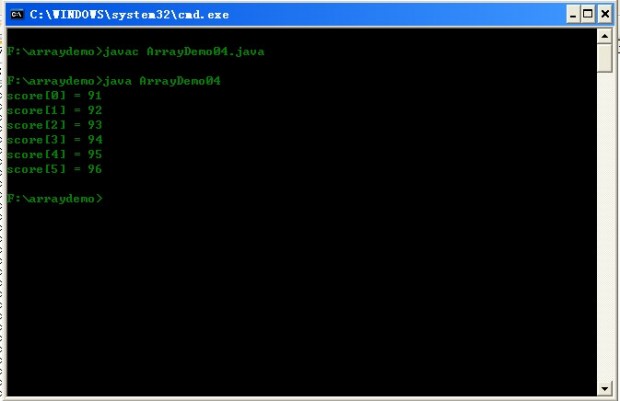 3.4观察两道范例:
3.4.1求出最大和最小值:
给出一个数组求出最大值和最小值
3.4观察两道范例:
3.4.1求出最大和最小值:
给出一个数组求出最大值和最小值
public class ArrayDemo05{public static void main(String args[]){int score[] = {67,89,87,69,90,100,75,90}; //静态初始化数组int max = 0;int min = 0;max = main = score[0] ; //把第一个元素的内容赋值给max和minfor(int x = 0;x<score.length;x++){ //循环求出最大值和最小值if(score[x]>max){max = score[x];}if(score[x]<min){min = score[x];}}System.out.println("最高成绩:" + max);System.out.println("最低成绩:" + min);}}
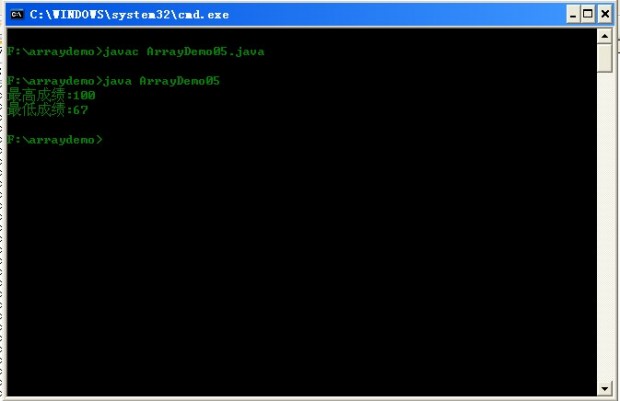 3.4.2排序
在数组中,排序是一个比较常见的算法。
通过一个简单的范例,来了解排序的基本操作。
3.4.2排序
在数组中,排序是一个比较常见的算法。
通过一个简单的范例,来了解排序的基本操作。
public class ArrayDemo06{public static void main(String args[]){int score[] = {67,89,87,69,90,100,75,90};for(int i=0;i<score.length;i++){for(int j=0;j<score.length;j++){if(score[i]<score[j]){ //交换位置,这里关系到到底是从大到小还是从小到大!int temp = score[i]; //中间变量score[i] = score[j];score[j] = temp;}}}for(int j=0;j<score.length;j++){ //循环输出System.out.print(score[j]+"\t");}}}
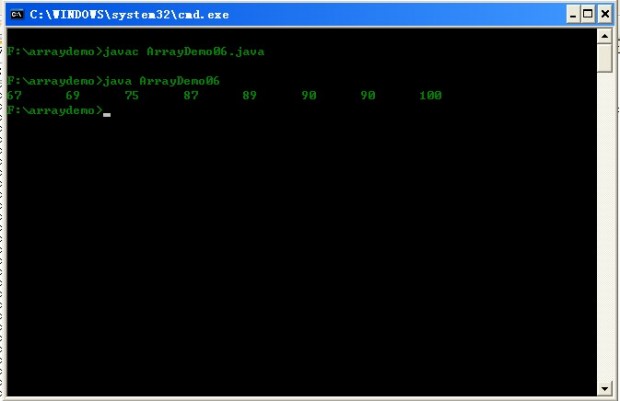 为了让大家可以更好的观察到每次的执行,下面在每次排序的时候都输出原始内容。
为了让大家可以更好的观察到每次的执行,下面在每次排序的时候都输出原始内容。
public class ArrayDemo07{public static void main(String args[]){int score[] = {67,89,87,69,90,100,75,90};for(int i=0;i<score.length;i++){for(int j=0;j<score.length;j++){if(score[i]<score[j]){ //交换位置,这里关系到到底是从大到小还是从小到大!int temp = score[i]; //中间变量score[i] = score[j];score[j] = temp;}}System.out.println("第" + i +"次排序的结果:\t");for(int j=0;j<score.length;j++){System.out.print(score[j]+"\t");}System.out.println("");}for(int i=0;i<score.length;i++){ //循环输出System.out.print(score[i]+"\t");}}}
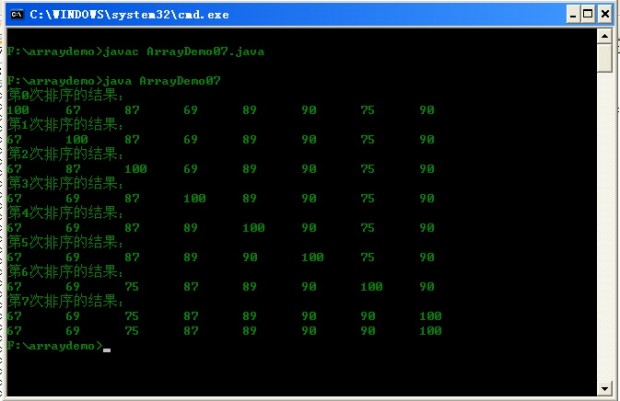 冒泡排序,自己观察运行的过程,来分析代码是如何操作的.
冒泡排序,自己观察运行的过程,来分析代码是如何操作的.
3.5二维数组
二维数组的声明方式和一维数组类似,内存的分配也是一样是用new这个关键字。 其声明与分配内存的格式如下所示: 1.动太初始化: 数据类型 数组名[][] 数组名 = new 数据类型[行的个数][列的个数]; 2.声明加初始化 数据类型 数组名[][] = new 数据类型[行的个数][列的个数] 3.二维数组静态初始化 数据类型 数组名[][] = {{第0行初值},{第0行初值},.....{第n行初值}} 如: int score[][] = null; //生命 score = new int[3][4]; //分配空间 或 int score = new int[3][4];public class ArrayDemo08{public static void main(String args[]){int score[][] = new int[4][3]; //声明并实例化二维数组score[0][1] = 30;score[1][1] = 30;score[2][2] = 30;score[3][1] = 30;score[1][1] = 30;for(int i=0;i<score.length;i++){for(int j=0;j<score[i].length;j++){System.out.print(score[i][j] + "\t");}System.out.println(); //换行}}}
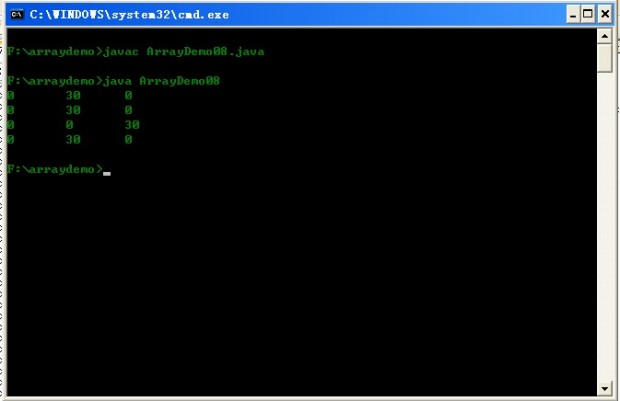
public class ArrayDemo09{public static void main(String args[]){int score[][] = {{67,61},{78,61,83},{99,100,98,66,95}}; //静态初始化完成,每行的数组元素个数不一样for(int i=0;i<score.length;i++){for(int j=0;j<score[i].length;j++){System.out.println(score[i][j] + "\t");}System.out.println("");}}}
3.6多维数组
三维数组的声明为int score[][][],而四维数组为int score[][][][].....,以此类推- public class ArrayDemo10{
- public static void main(String args[]){
- int score[][] = {
- {
- {5,1},{6,7}
- },
- {
- {9,4},{8,3}
- }
- }; //静态初始化完成,每行的数组元素个数不一样
- for(int i=0;i<score.length;i++){
- for(int j=0;j<score[i].length;j++){
- for(int k=0;k<score[i][j].length;k++){
- System.out.println("score[" + i + "]["+ j +"]["+ k +"] = " + score[i][j][k] + "\t");
- }
- }
- System.out.println("");
- }
- }
- }
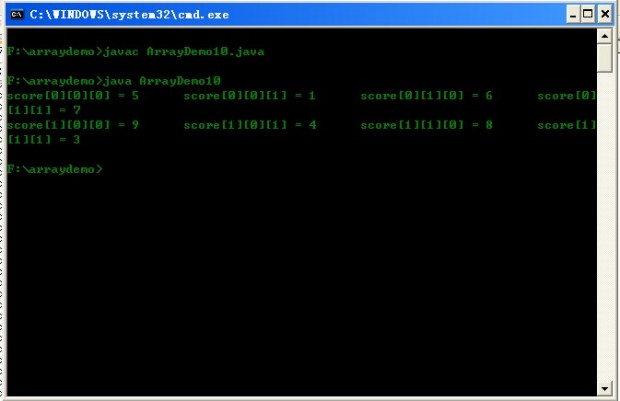
爆款云服务器s6 2核4G 低至0.46/天,具体规则查看活动详情
